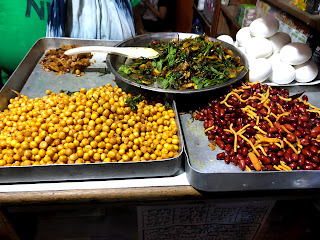The
Majestic Manipur
Through Moirang roads,
I discovered Manipur in a new dimension. INA or Indian National Army led by
Netaji Subhash Chandra Bose hoisted the Indian flag in 1944 much before Indian
Independence.
 |
| The Acknowledgement |
Apart from
this, the place has many things to offer. One major thing is the colorful
textiles of Manipur. The unique textiles are often woven by Manipuri females in
basic handloom using colorful yarns bringing out the enticing beauty of these textiles.
I would now talk
about three of my favorite textiles of Manipur which till date mesmerizes me with its
wonderful color and artistic skills. First is the Sangai motif found in the
textiles of Manipur, Second is the Moirangphi textile and third the most
astonishing one is the use of orchids motifs from the state Manipur
Sangai: Sangai
is the state animal of Manipur. This deer is an endangered and rare species and
found in Manipur in their natural habitat. The Sangai deer is often seen as a
textile motif in various fabrics of Manipur. The fighting spirit of the dancing
deer are captured in its true sense in the jamdani motifs of Manipur. The
wildness is tamed in the framed form of warp and weft of Manipuri textile. The
majestic forms of the Sangai deer motifs not only praise the tribes’ gratitude
towards nature but also tells tales of legend and bravery taking shape in
textile art.
 |
| The Sangai Deer in the making |
 |
| The dancing deer come alive |
In my several visits to this beautiful state of North East of India, I have come across this Moirangphi textiles. In Meitei language (the local language of Manipur) Phi is a term for fabrics or a piece of fabric. And these phis woven in the place in Moirang is called as Moirangphi. The Moirangphis are used in several ways. Either as a sarong or a phanek which is wrapped around their lower body or as a saree. This particular piece has delicate temples running throughout the edges of the fabrics. These temples resembles the temple structure which is conical in feature. The Moirangphi with temple motifs comes in soft pastel colors and have air like pristine texture. The fabric itself makes it look pious and breezy which shows the extreme devotion of the women weavers who have expressed their prayer through this textile.
 |
| The making of temple motif and jamdani florals. |
 |
| The Temple Motif |
The land of
Orchids: The state of Manipur is known for its flora and fauna. The state has
designated land for orchid plants and has 220 species pf orchids. The beautiful
orchids are exported to Far East Asia from Manipur. The motifs of orchids are
given life on the transparent fabrics through jamdani or extra weft technique
added with imaginations of weavers. The supple and light fabrics are rendered
through weave and color shading such a way that it makes the floral motifs
three dimensional and lively. Due to high skill involved to do this particular
motif, very few women weavers are left whose nimble fingers weave this magic.
The rendering of colors are so important to bring life to a flat motif, the
visual skill is also required for the magic to happen. Subtle pastel colors are
often seen used for this motifs. As I have already mentioned that this jamdani
orchid motifs require high skill of not only of hands but vision also, there is
a dwindling number of weavers who are efficient enough to weave.
The hands that wove these impeccable orchids: Ms. Saya Devi Wangkhei
Ending here for the time being, Manipur has many folds to be unfolded. The journey has just begun. The tensed and peaceful days are yet to be explored.



